May 20, 2025 | 03:12 GMT +7
May 20, 2025 | 03:12 GMT +7
Hotline: 0913.378.918
May 20, 2025 | 03:12 GMT +7
Hotline: 0913.378.918
Cassava is known as a crop that requires little land and investment. From being a crop that helps alleviate hunger and poverty, cassava has secured a significant position in Vietnam's and the world's economic map. In 2023, despite a decrease in cassava exports and cassava-related products compared to 2022, it still remained one of the agricultural export items valued at over $ 1 billion.
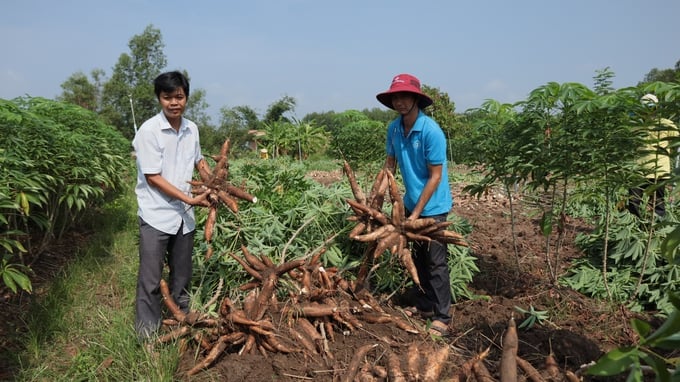
Cassava is the main crop, bringing decent income to the people of Tây Ninh. Photo: Tran Trung.
In Tay Ninh, where the predominantly sandy soil on an ancient alluvial foundation is suitable for cassava, thanks to good farming techniques and bold investments in scientific and technological advancement, especially inefficient irrigation systems allowing year-round farming, cassava yields are 1.5 times higher than the national average. Over time, cassava has become a major crop, providing decent income for the people of Tây Ninh.
With Tay Ninh's weather conditions featuring a prolonged dry season of six months, the time from planting to harvesting cassava takes 10 months. During the first three months, cassava requires ample irrigation, making proactive irrigation a prerequisite for its high productivity. Currently, cassava irrigation techniques include sprinkler irrigation using nozzles and automated misting.
We visited the cassava fields of Mr Nguyen Van Cho in Cha aà commune, Duong Minh Chau district, Tay Ninh. Unable to hide his excitement, Mr Cho shared that this year's cassava yield exceeded 50 tons/ha, bringing profits of nearly VND 80 million/ha, all thanks to an automated irrigation system that conserves water.
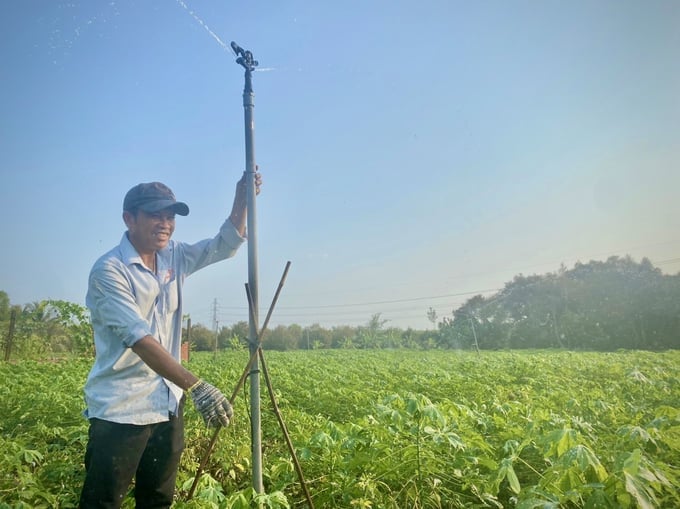
Mr Nguyen Van Cho with his family's automated irrigation technology in the cassava field. Photo: Tran Trung.
According to Mr Cho, cassava requires plenty of water during its initial growth stage. Unlike relying solely on rainfall like in many other regions, he and many locals here have been proactively irrigating their cassava fields from the early stages. However, in the past, most people used inconvenient gravity irrigation methods, resulting in uneven water distribution and wastage. In recent years, amidst erratic weather patterns and increasingly scarce water resources, Mr Cho boldly invested in an advanced irrigation system using rotating nozzles, which saved over 40% of water consumption, reduced labour, cut costs, and increased income.
"The investment cost for an automated irrigation system using rotating nozzles is around VND 20 million/ha. Installing this system is quite simple, but it's essential for farmers to calculate water distribution according to the plant's needs, providing sufficient and uniform water supply to support robust plant growth. Each system can be used for 3 - 5 years, and it's portable, so even though my family invested in only one system, it can be used for all 3 ha of cassava. I have seen the numerous benefits they bring, and after just one crop cycle, it's more than enough to recover the investment", Mr Cho enthusiastically shared.
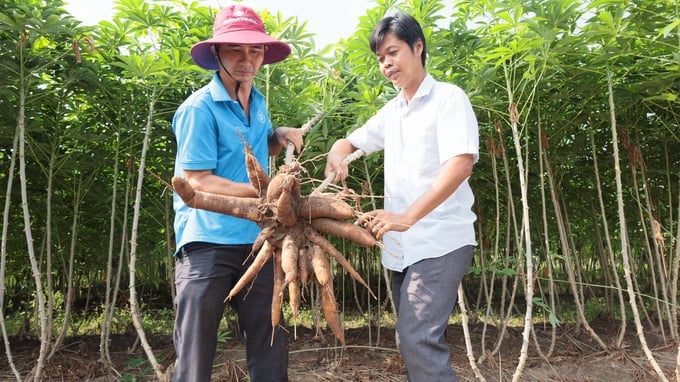
Mr Duong Thanh Phuong (wearing white) stated that cassava productivity increased by 30 - 50% with the application of water-saving irrigation. Photo: Tran Trung.
Similarly, in the border district of Tan Chau - considered the cassava capital of Tay Ninh province, people have recognized the benefits of water-saving automated irrigation systems, and now the majority of cassava growers in the area have adopted this technology. Mr Duong Thanh Phuong, the head of the Agricultural Promotion Station in Tan Chau district, enthusiastically shared that currently, the total cassava-growing area in the region exceeds 20,000 ha, with over 95% of the area utilizing water-saving automated irrigation.
"Areas growing cassava using automated irrigation methods have shown high efficiency. Specifically, cassava yields have increased by 30 - 50% compared to non-irrigated areas (cassava without irrigation yields only 20 - 25 tons/ha, while irrigated cassava can reach 40 - 50 tons/ha depending on the level of fertilization). Additionally, automated irrigation helps wash away spider mites, pests, and diseases on cassava plants," Mr Duong Thanh Phuong, head of the Agricultural Promotion Station in Tan Chau district, explained.
According to the Tay Ninh Agricultural Promotion Center, the cassava-growing area in the province has been continuously increasing in recent years. By the end of 2023, Tay Ninh had over 60,000 ha of cassava. In the future, Tay Ninh aims to maintain and develop cassava growing areas at around 55,000 to 65,000 ha per year.
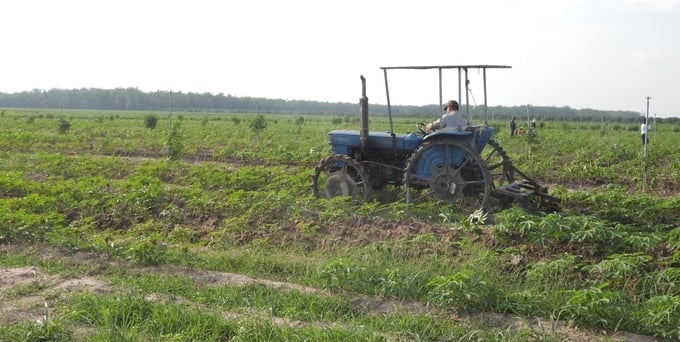
Farmers in Tay Ninh proactively apply mechanization in land preparation, and bed shaping, and combine it with organic fertilizer application to improve soil texture, making it more friable and water-saving for irrigation. Photo: Tran Trung.
Although the province has a relatively comprehensive irrigation system that provides abundant freshwater, which is highly favourable for cassava cultivation, water resources are limited. The impact of climate change has led to signs of groundwater depletion in the region in recent years. However, the people of Tay Ninh have rich experience in cassava production. Besides adopting water-saving irrigation, they have also mechanized land preparation, bed forming, and combined organic fertilization to improve soil structure, save irrigation water, and maintain good moisture levels. This approach has yielded positive results for cassava growers in Tay Ninh.
In addition to these measures, cultivating new cassava varieties with resistance to leaf blight and drought, such as HN1, HN3, and HN5, and changing planting methods, are also secrets for cassava growers in Tây Ninh to overcome challenges. Instead of traditional horizontal planting, many farmers have switched to vertical planting. "With horizontal planting, cassava tubers only grow on one side of the root. However, with vertical planting, tubers grow evenly around the root, resulting in a higher quantity of tubers. Additionally, it helps the plant resist breakage and requires less water", shared an experienced cassava farmer in Tay Ninh.

Introducing new cassava varieties with disease resistance and drought tolerance such as HN1, HN3, and HN5... and changing cultivation methods are also the keys for cassava growers in Tay Ninh to overcome adversities. Photo: Tran Trung.
Support conditions: For individuals, the minimum irrigated area is 0.3 ha and support for individuals is facilitated through grassroots irrigation organizations. For grassroots irrigation organizations, the minimum irrigated area is 2 ha, and they must have a contract with households or individuals directly involved in production.
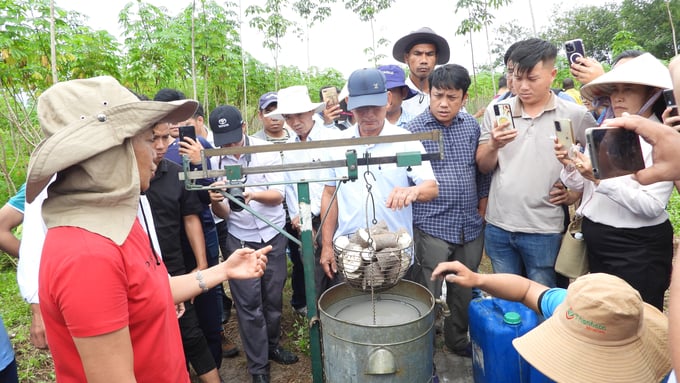
With the support from state policies, the cassava industry in Tây Ninh, specifically, and nationwide in general, will continue to maintain its position. Photo: Tran Trung.
Translated by Hoang Duy
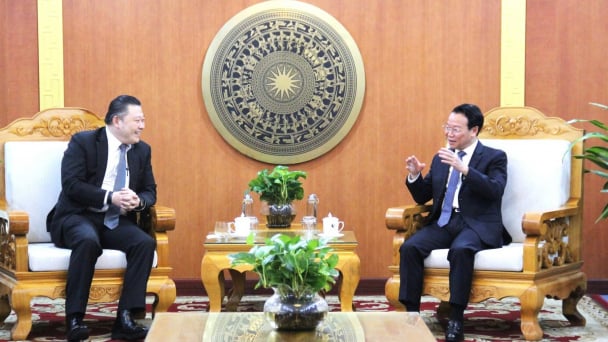
(VAN) Minister of Agriculture and Environment Do Duc Duy held a meeting with Soopakij Chearavanont, Chairman of C.P. Group, on May 15.
/2025/05/16/3800-0-nongnghiep-143756.jpg)
(VAN) Suntory PepsiCo Vietnam coordinated with the Ministry of Education and Training to implement an education program on water conservation, reaching nearly 1 million primary school students nationwide.

(VAN) Vietnam’s TH Group officially put its high-tech fresh milk processing plant into operation in the Russian Federation, marking a historic moment as the first TH true MILK cartons were produced in Russia.

(VAN) Use of high-quality broodstock and biotechnology is regarded as the most effective approach to ensuring sustainable and economically viable shrimp aquaculture ahead of climate change and the emergence of increasingly intricate disease patterns.

(VAN) Carbon farming is a form of agricultural practices that helps absorb more greenhouse gases than it emits, through smart management of soil, crops, and livestock.

(VAN) This is a key content of the Memorandum of Understanding recently signed between the Vietnam Fisheries Society and Kunihiro Inc of Japan.

(VAN) To achieve the goal, local authorities and businesses in Kon Tum province have fully prepared the necessary conditions for the new Ngoc Linh ginseng planting season.